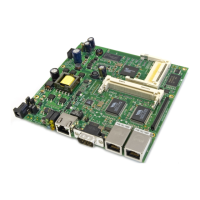
Do you have a question about the MikroTik RouterBOARD 532 and is the answer not in the manual?
| RAM | 64 MB |
|---|---|
| Storage | 64MB NAND |
| Power Supply/Input | 8-30V DC |
| MiniPCI slots | 1 |
| Operating System | RouterOS |
| USB Ports | 1 |
| Serial port | 1x DB9 serial port |
Details MikroTikls SIA's hardware warranty for defects in materials and workmanship.
Information on trademarks and essential voltage input cautions for system safety.
Diagram showing placement of components and connectors on the RouterBOARD 500 series.
Overview of the internal architecture and data flow of the RouterBOARD 500 series.
Details CPU, memory, storage, ports, power, dimensions, and environmental limits.
Options for Ethernet and MiniPCI slots available with different daughterboards.
Descriptions of different RouterBOARD 500 series build versions like RB532c, RB532p1, etc.
Information on onboard memory, NAND storage, and CompactFlash interface.
Details on the MiniPCI slot, including power and card compatibility.
Description of LAN1 (with PoE), LAN2, and LAN3 ports, including PoE and Auto MDI/X.
Explanation of Power LED, User LED, and MiniPCI LEDs status indicators.
Steps for initial board use, jumper configuration, card installation, and powering options.
Describes booting from NAND, CompactFlash, or network.
Information on supported OSs like MikroTik RouterOS and Linux.
Details MIPS32 architecture, MIPS 4Kc CPU core, and instruction set.
Functionality and supported OSs for the RouterBOOT boot loader.
How to access and configure boot loader settings via serial console.
Explanation of boot delay, boot key, serial console, boot device, and other settings.
Instructions for overclocking the CPU and its default settings.
Procedures for updating the RouterBOOT firmware via serial or network.
Detailed pinout and function for all onboard connectors (J1-J16).
Explanation of the function and settings for all onboard jumpers (JP1-JP7).
Index for buttons (S1, S2) and pinouts for Ethernet and serial cables.
